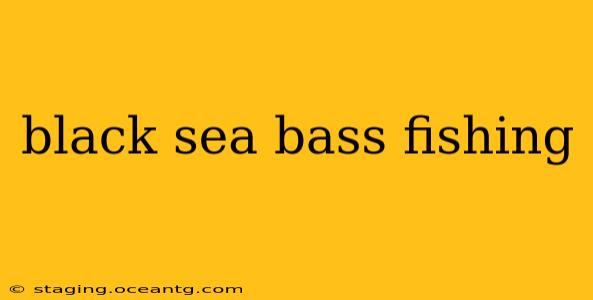Black sea bass are a prized game fish, known for their strong fight and delicious meat. Targeting these fish requires understanding their habitat, feeding habits, and the best techniques for catching them. This comprehensive guide covers everything you need to know for a successful black sea bass fishing trip.
Where to Find Black Sea Bass?
Black sea bass are found along the Atlantic coast of North America, from Massachusetts to Florida. They prefer rocky reefs, wrecks, and artificial structures, particularly in water depths ranging from 30 to 200 feet. They are often found near areas with strong currents and abundant baitfish. Knowing their preferred habitat is key to successfully locating them. Look for areas with significant bottom structure, using your fish finder to identify promising spots.
What is the best time of year to fish for black sea bass?
The best time to fish for black sea bass is generally during their spawning season, which typically runs from May to October. During this time, the fish are more active and readily bite. However, black sea bass can be caught year-round, with some success in cooler months.
What depths do black sea bass live in?
Black sea bass inhabit a range of depths, but are most commonly found in waters from 30 to 200 feet deep. They prefer rocky bottoms and structures in these depths. Shallower waters might hold juveniles, while deeper waters may be home to larger, more mature fish.
Black Sea Bass Fishing Techniques
Several techniques are effective for catching black sea bass. The most popular include:
-
Jigging: This involves vertically jigging a lead head jig tipped with bait or a soft plastic lure. The jig imitates the movement of small baitfish, attracting the attention of black sea bass. Experiment with different jig weights and colors to find what works best in different conditions.
-
Bottom fishing: This involves using a heavier weight to keep your bait or lure on the bottom, near the structure where the black sea bass reside. Popular baits include clams, squid, and mussels.
-
Drift fishing: This technique involves letting your bait drift along the bottom with the current, allowing the sea bass to naturally encounter it. This is especially effective in areas with strong currents.
What Bait and Lures Work Best?
Black sea bass are opportunistic feeders, readily taking various baits and lures. Some of the most effective include:
-
Live bait: Clams, mussels, and small fish are excellent live bait choices.
-
Artificial lures: Soft plastic jigs, bucktails, and metal jigs are all effective lures. Experiment with different colors and sizes to determine what works best in the specific conditions you're fishing in.
What is the best bait for black sea bass?
While many baits will attract black sea bass, live clams, mussels, and squid are generally considered the best choices. Their natural scent and movement prove irresistible to these bottom-feeding fish.
Black Sea Bass Fishing Regulations
Always check your local fishing regulations before heading out. These regulations vary by location and may include size and bag limits, as well as seasonal closures. Respecting these regulations is crucial for the conservation of this valuable resource. Fishing responsibly ensures the sustainability of the black sea bass population for future generations.
Essential Gear for Black Sea Bass Fishing
Successful black sea bass fishing requires the right gear. This includes:
-
Rod and reel: A medium-heavy action rod and reel capable of handling the weight of jigs and the strength of the fish.
-
Line: Braid or monofilament line with a test strength of at least 20 pounds.
-
Terminal tackle: Hooks, swivels, weights, and leaders appropriate for your chosen technique.
-
Fish finder: A good fish finder can be invaluable in locating black sea bass and their preferred habitat.
This guide provides a solid foundation for successful black sea bass fishing. Remember to research your specific fishing location, practice safe fishing techniques, and always adhere to local regulations. Tight lines!
